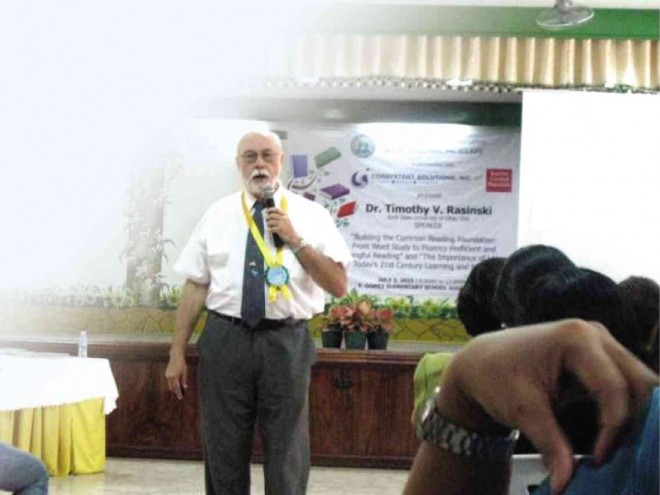Songs and poems enhance reading skills
Dr. Timothy Rasinski, a well-renowned educator and reading expert, says fluency, poetry and song instruction can make a big difference in teaching reading.
Rasinski, who was in the Philippines recently, discussed with local educators some techniques to produce students who could read with good comprehension.
He said he found automaticity and prosody indispensable to fluency instruction. Goals could be achieved through wide and deep reading, he said.
Rasinski said wide reading was a common classroom practice of reading a text once, followed by discussion, response and instruction to develop specific reading strategies and skills. The routine would be followed with every different text.
Deep reading is more commonly referred to as repeated reading (Samuels, 1979). A student reads a single text repeatedly until a level of fluency is achieved.
Wide and deep reading is fundamental to any effective fluency program or intervention. Reading rate improvement should be through authentic, wide and deep reading practices.
Automaticity
Automaticity refers to the ability to recognize words automatically or effortlessly (LaBerge & Samuels, 1974). All readers have a limited amount of attention, what Rasinski called cognitive energy.
“If they have to use too much of that cognitive energy to decode the words in text, they have little remaining for the more important task in reading comprehension,” he said.
“For many readers, comprehension while reading suffers not because the readers have insufficient cognitive resources to make meaning out of the text read, but because they depleted those resources by having to employ them in word recognition.”
If automaticity was linked to word recognition, Rasinski said prosody completed the bridge by linking fluency to comprehension. The more common term for prosody is reading with expression.
Prosody enhances and adds to the meaning of a text through wide and deep reading practice. Readers encounter different texts requiring different prosodic elements to read with appropriate expression and meaning.
As readers read deeply (reading a text several times), they gradually recognize and insert into their reading prosodic essentials that allow for a meaningful and expressive rendition of the text.
Poetry for strugglers
The students’ initial readings of poems are awkward, mechanical and in monotone. However, through teacher modeling, supported by practice with feedback, children are eventually able to read a poem with good expression and confidence.
This was Rasinski’s experience in his reading clinic where students mastered one or two poems and performed them for classmates, teachers and other adults. The practice and performance of poetry were viewed as key to students’ growth in reading.
In five weeks, Rasinski and his team saw students’ significant and substantial progress in word recognition and reading fluency.
Improvements in reading foundational skills led to gains in comprehension, the ultimate goal of reading.
Reading by ‘karaoke’
Rasinski and his team thought singing (the words to the songs displayed simultaneously) could be a very useful instructional tool for beginners.
When students follow the lyrics as they sing, they are, in essence, reading. Singing increases reading time.
A goal for beginners is to develop a robust sight vocabulary. Sight words are essentially memorized words—by sight and sound. Words in songs are easier to remember, offering a good opportunity for developing young students’ sight vocabulary.
Song lyrics (a form of poetry) often rhyme. Playing with the sounds of language through song can help develop phonemic cognizance. The ability to sing and read lyrics can improve young, struggling readers’ confidence.
“The beauty of singing in the classroom is its simplicity and joyfulness. Songs are everywhere. Bring more singing into your own classroom. Teach your children a new song every week. Be sure to have the written lyrics available for students to read. Sing the same song repeatedly (repeated reading) until they are able to sing the song fluently. What could be better—children having fun singing while learning to read at the same time!” Rasinski said.
Rasinski challenged teachers to conduct reading instruction in ways that were authentic, engaging and meaningful for students.
Engaging students through songs, poems and other reading materials that promote prosody and automaticity, combined with wide reading, will help improve comprehension.
Deep or repeated reading should be well integrated into the curriculum.
The writer is a master teacher at J. Zamora Elementary School, Manila, and is the Reading and Information and Communication Technology district coordinator.















